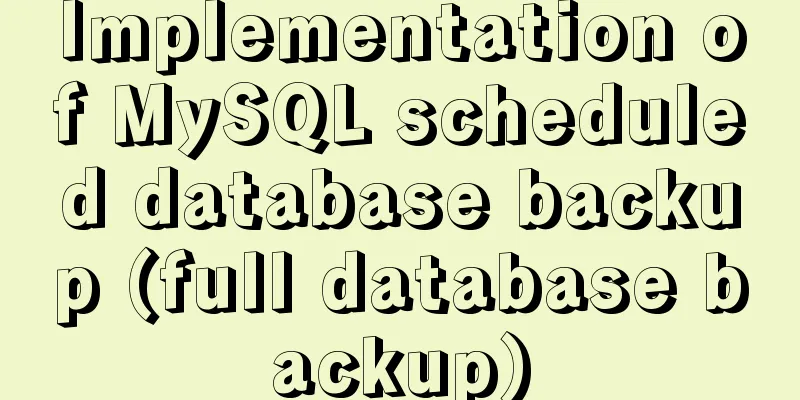Implementation of MySQL scheduled database backup (full database backup)

1. MySQL data backup 1.1, mysqldump command to back up dataMySQL provides a convenient tool mysqldump for exporting database data and files through the command line. We can directly export and dump the database content through the command line. First, let's take a brief look at the usage of the mysqldump command: #MySQLdump commonly used mysqldump -u root -p --databases database 1 database 2 > xxx.sql 1.2、 Common operation examples of mysqldump1. Back up the data and structure of all databases mysqldump -uroot -p123456 -A > /data/mysqlDump/mydb.sql 2. Back up the structure of the entire database (add -d parameter) mysqldump -uroot -p123456 -A -d > /data/mysqlDump/mydb.sql 3. Back up all database data (add -t parameter) mysqldump -uroot -p123456 -A -t > /data/mysqlDump/mydb.sql 4. Back up the data and structure of a single database (database name mydb) mysqldump -uroot-p123456 mydb > /data/mysqlDump/mydb.sql 5. Back up the structure of a single database mysqldump -uroot -p123456 mydb -d > /data/mysqlDump/mydb.sql 6. Back up data of a single database mysqldump -uroot -p123456 mydb -t > /data/mysqlDump/mydb.sql 7. Back up the data and structure of multiple tables (the method for backing up data and structure separately is the same as above) mysqldump -uroot -p123456 mydb t1 t2 > /data/mysqlDump/mydb.sql 8. Back up multiple databases at once mysqldump -uroot -p123456 --databases db1 db2 > /data/mysqlDump/mydb.sql 1.3. Restore MySQL backup contentThere are two ways to restore. The first is in the MySQL command line, and the second is to use the SHELL line to complete the restore. 1. In the system command line, enter the following to restore: mysql -uroot -p123456 < /data/mysqlDump/mydb.sql 2. After logging into the MySQL system, use the source command to find the file in the corresponding system and restore it: mysql> source /data/mysqlDump/mydb.sql 2. Write scripts to maintain backup database filesIn Linux, BASH scripts are usually used to write the content that needs to be executed, and the crontab command is used to execute the command at a scheduled time to realize automatic log generation. The following code function is to back up MySQL and, in conjunction with crontab, back up the daily MySQL database records for the past month (31 days). 2.1. Write BASH to maintain a fixed number of backup filesIn Linux, use vi or vim to write the script content and name it: mysql_dump_script.sh
#!/bin/bash
#Save the number of backups, back up 31 days of data number=31
#Backup save path backup_dir=/root/mysqlbackup
#Date dd=`date +%Y-%m-%d-%H-%M-%S`
#Backup tool tool=mysqldump
#Username username=root
# Password password = TankB214
#The database to be backed up database_name=edoctor
#If the folder does not exist, create it if [ ! -d $backup_dir ];
then
mkdir -p $backup_dir;
fi
#Simple way to write mysqldump -u root -p123456 users > /root/mysqlbackup/users-$filename.sql
$tool -u $username -p$password $database_name > $backup_dir/$database_name-$dd.sql
#Write to create backup log echo "create $backup_dir/$database_name-$dd.dupm" >> $backup_dir/log.txt
#Find the backup that needs to be deleted delfile=`ls -l -crt $backup_dir/*.sql | awk '{print $9 }' | head -1`
#Judge whether the current number of backups is greater than $number
count=`ls -l -crt $backup_dir/*.sql | awk '{print $9 }' | wc -l`
if [ $count -gt $number ]
then
#Delete the earliest generated backup and keep only number of backups rm $delfile
#Write the delete file log echo "delete $delfile" >> $backup_dir/log.txt
fiThe main meanings of the above code are as follows: 1. First, set various parameters, such as the maximum number of numbers to be backed up, backup path, user name, password, etc. 2. Execute the mysqldump command to save the backup file and print the operation to log.txt in the same directory to mark the operation log. 3. Define the files to be deleted: Use the ls command to obtain the ninth column, which is the file name column, and then use head -1 The file with the latest operation time is defined by the implementation and needs to be deleted. 4. Define the number of backups: add the ls command wc -l Count the number of lines in files ending with sql. 5. If the file exceeds the limit, delete the earliest created sql file 2.2. Use crontab to execute backup scripts regularly In LINUX, periodic tasks are usually handled by the cron daemon process [ps -ef | grep cron]. Cron reads one or more configuration files that contain command lines and the times they are called. 1. Cron service Cron is a scheduled execution tool under Linux that can run jobs without human intervention. service crond start //Start the service service crond stop //Shut down the service service crond restart //Restart the service service crond reload //Reload the configuration service crond status //Check the service status 2. Crontab Syntax The crontab command is used to install, remove, or list the tables used to drive the cron daemon. The user puts the command sequence to be executed in the crontab file to get it executed. Each user can have his or her own crontab file. The crontab file in /var/spool/cron cannot be created or modified directly. The crontab file is created by the crontab command.
3. Create a cron script Step 1: Write a cron script file and name it mysqlRollBack.cron. Note: This operation directly replaces the crontab of the user, rather than adding a new one Regularly execute the scheduled task script (remember to give the shell script execution permission first) 0 2 * * * /root/mysql_backup_script.sh Then use the crontab command to write a scheduled script regularly crontab mysqlRollback.cron Then use the command to check whether the scheduled task has been created: crontab -l Attached is an example of using crontab: 1. 6am every day 0 6 * * * echo "Good morning." >> /tmp/test.txt //Note that with just echo, you cannot see any output on the screen because cron emails any output to root's mailbox. 2. Every two hours 0 */2 * * * echo "Have a break now." >> /tmp/test.txt 3. Every two hours between 11pm and 8am and at 8am 0 23-7/2,8 * * * echo "Have a good dream" >> /tmp/test.txt 4. On the 4th of every month and every Monday to Wednesday at 11am 0 11 4 * 1-3 command line 5. January 1 at 4 a.m. 0 4 1 1 * command line SHELL=/bin/bash PATH=/sbin:/bin:/usr/sbin:/usr/bin MAILTO=root //If an error occurs or data is output, the data will be sent to this account as an email HOME=/ 6. Execute the script in /etc/cron.hourly every hour 01 * * * * root run-parts /etc/cron.hourly 7. Execute the script in /etc/cron.daily every day 02 4 * * * root run-parts /etc/cron.daily 8. Execute the script in /etc/cron.weekly every week 22 4 * * 0 root run-parts /etc/cron.weekly 9. Execute the script in /etc/cron.monthly every month 42 4 1 * * root run-parts /etc/cron.monthly Note: The "run-parts" parameter. If you remove this parameter, you can write the name of a script to be run instead of the folder name. 10. Execute the command at 5 min, 15 min, 25 min, 35 min, 45 min, and 55 min at 4, 5, and 6 p.m. every day. 5, 15, 25, 35, 45, 55, 16, 17, 18 * * * command 11. The system will enter maintenance mode and restart at 3:00 pm every Monday, Wednesday and Friday. 00 15 * * 1,3,5 shutdown -r +5 12. At 10 and 40 minutes of every hour, execute the command innd/bbslin in the user directory: 10,40 * * * * innd/bbslink 13. Execute the bin/account command in the user directory at 1 minute every hour: 1 * * * * bin/account 3. Screenshot of execution effectThe following are the screenshots of my test every minute, and the corresponding code is as follows: * * * * * /root/mysql_backup_script.sh Effect screenshots:
The log.txt file records the detailed log of the backup operation:
References for this article:1. Common commands for MySQLdump: https://www.cnblogs.com/smail-bao/p/6402265.html (Blog Park) 2. Use Shell script to back up the MySQL database: https://www.cnblogs.com/mracale/p/7251292.html (Blog Park) 3. Detailed explanation of Crontab scheduled execution task command under Linux: https://www.cnblogs.com/longjshz/p/5779215.html (Blog Park) This concludes this article on the implementation of scheduled MySQL database backup (full database backup). For more relevant MySQL scheduled backup content, please search for previous articles on 123WORDPRESS.COM or continue to browse the following related articles. I hope you will support 123WORDPRESS.COM in the future! You may also be interested in:
|
<<: Example of horizontal and vertical centering of div sub-element using CSS
>>: TypeScript Enumeration Type
Recommend
A comparison between the href attribute and onclick event of the a tag
First of all, let's talk about the execution ...
Several situations where div is covered by iframe and their solutions
Similar structures: Copy code The code is as foll...
Tomcat parses XML and creates objects through reflection
The following example code introduces the princip...
Docker /var/lib/docker/aufs/mnt directory cleaning method
The company's service uses docker, and the di...
Analysis of Linux kernel scheduler source code initialization
Table of contents 1. Introduction 2. Basic Concep...
Learn the basics of JavaScript DOM operations in one article
DOM Concepts DOM: document object model: The docu...
mysql installer community 8.0.16.0 installation and configuration graphic tutorial
mysql installer community 8.0.16.0 installation g...
The principle and implementation of js drag effect
The drag function is mainly used to allow users t...
Summary of various implementation methods of mysql database backup
This article describes various ways to implement ...
Detailed explanation of the execution order of JavaScript Alert function
Table of contents question analyze solve Replace ...
Tutorial on logging into MySQL after installing Mysql 5.7.17
The installation of mysql-5.7.17 is introduced be...
Detailed explanation of how to solve the position:fixed fixed positioning offset problem
question CSS fixed positioning position:fixed is ...
Tomcat security specifications (tomcat security reinforcement and specifications)
tomcat is an open source web server. The web base...
Div exceeds hidden text and hides the CSS code beyond the div part
Before hiding: After hiding: CSS: Copy code The co...
25 CSS frameworks, tools, software and templates shared
Sprite Cow download CSS Lint download Prefixr dow...











